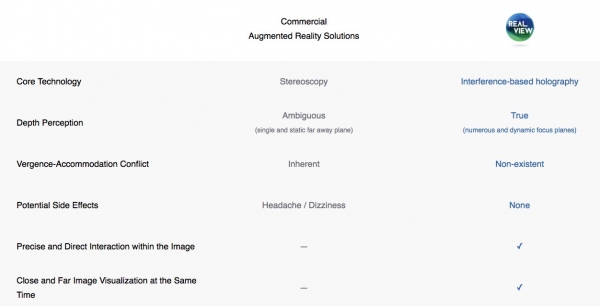Since the first attempts at creating head mounted displays and at least since Star Wars, the hologram has been the holy grail of the display technology. Today, the term is more and more deteriorating into a marketing word that seems to mean anything optically clever. If it has a holographic component, let’s just call it a holographic display.
From a technical standpoint a hologram is pretty clearly defined and it involves some form of coherent light beam, typically a laser. From a less technical standpoint, a hologram creates a 3D object in space that I can move around and see the side or rear view depending on my point of view. It solves many of the shortcomings of a 3D TV based on stereoscopy. The real issue with holography is that nobody can really do it. All implementations so far have some shortcomings that limit the viability of this technology, more or less, to some high end applications or the research lab.
Most holograms that are shown to us aren’t real holograms, they are optical trickery that make us believe we see a hologram. Here is where RealView, an Israel based start up company that works on interactive live holography as the best technology to create an augmented reality headset differs from the rest of the pack. Interactive live holography is when a computer generates moving holograms in real time. When Holography is the holy grail, interactive live holography is the holiest of grails. It means just falling short of reality itself. In the perfect implementation, we are talking about the Holodeck (for all Star Trek enthusiasts).
RealView claims that their “proprietary Digital Light Shaping technology provides a unique natural user experience, creating the only accurate, three-dimensional interactive holograms within hands reach”. That’s a high goal to achieve. They compare themselves against other augmented reality solutions that are based on stereoscopy with all the shortcomings we had in the 3D TV. Of course, without the glasses issue, as the displays themselves are part of the glasses.
 Source: RealView
Source: RealView
Their own description insists that they are using interference based holography, which would suggest that they are using spatial light modulators. For some more information on the approaches to holography please refer to multiple sources on the web, starting with Wikipedia that has simple overview articles for holography and computer generated holography.
The key to understanding what RealView may be doing is in their statement that they have “numerous and dynamic focus planes”. This is described and discussed in more depth in the article “‘HOLOSCOPE’ Headset Claims to Solve AR Display Hurdle with True Holography” by Dr. Oliver Kreylos, published by RoadtoVR.com. He comes to the conclusion that RealView may be using an approach of creating multiple 2D holograms via Fourier transformation and creating the resulting image by combining these 2D holograms. This approach would drastically reduce the computation requirements, one of the key barriers to overcome for live holography.
Source: RealView
The resulting images looks very good and as RealView insists, all the images showing their holograms are actually acquired with standard camera equipment, which would of course exclude Photoshop as a source for the images. They also have some videos that show how the user can interact with the hologram. It seems that the development used medical applications as the target for their technology prototypes.
We did reach out to RealView to learn little more about their approach, but were not successful in getting any answers. It seems that for now we have to rely on speculation until RealView is ready to talk about their Digital Light Shaping technology in more detail. – NH

